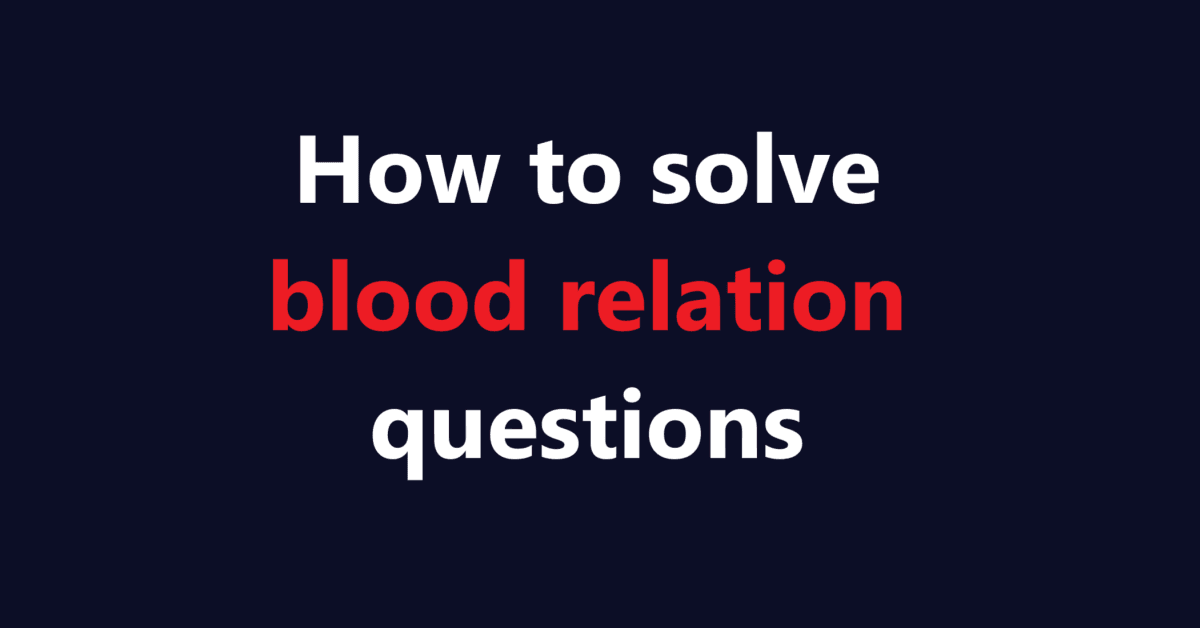Blood relation questions can often be complex, as they require a clear understanding of family relationships and logical reasoning. Here’s an in-depth guide on how to approach and solve blood relation problems effectively.
Step-by-Step Approach to Solve Blood Relation Questions
1. Understand Basic Relationship Terminology
- Familiarize yourself with basic family terms, as these are fundamental to solving blood relationship questions. Here are key terms:
- Parents: Mother and Father
- Siblings: Brother and Sister
- Children: Son and Daughter
- Grandparents: Maternal (Mother’s side) and Paternal (Father’s side)
- Aunts/Uncles: Father’s or Mother’s siblings
- Cousins: Children of your aunts and uncles
- Nephew/Niece: Children of your siblings
Understanding these terms will help you visualize and deduce relationships accurately.
2. Draw a Family Tree
- When faced with a blood relation question, visualizing the relationships can make it easier to understand. Drawing a family tree can be very helpful. Start by placing the main individuals at the center and connecting their relationships with lines or branches.
Example:
If the statement is “A is the brother of B. B is the father of C,” you can visualize it like this:
A
|
B
|
C
3. Identify Relationships Step by Step
- Break down the statements one at a time. For instance, if multiple statements are given about relationships, take note of each relationship before moving to the next.
- Take some time to analyze and combine the relationships logically.
Example:
From “A is the brother of B” and “B is the father of C”:
- A is B’s brother.
- B is C’s father, which makes A the uncle of C.
4. Use Logical Deductions
- Many blood relation questions involve making logical deductions. You might encounter premises that allow you to infer conclusions.
- Remember that:
- Siblings: Share the same parents.
- Children: Are the next generation in relation to their parents.
- Grandparents: Are one generation up from the parents.
5. Practice Identifying Common Patterns
- Certain patterns recur frequently within blood relation questions. For example:
- The relationship between uncles/aunts and their nieces/nephews.
- Relationships between grandparents and grandchildren.
- Recognizing these patterns can speed up your analysis and help you answer questions more quickly.
6. Pay Attention to Gender Indications
- Be mindful of gender-specific terms like mother, father, brother, and sister. This is crucial as relationships can drastically change depending on the gender.
Example:
If it states “A is the brother of B,” then A is male, which influences how B is related to others.
7. Solve with Multiple Choice Formats
- Blood relation questions may appear in multiple-choice formats in exams. Always read all the options before choosing your answer.
- Eliminate options that do not seem plausible based on your analysis. This can help narrow down the possibilities.
8. Practice with Different Scenarios
- To become proficient in solving blood relation questions, practice different scenarios and problems. This will enhance your familiarity with various styles of questions.
Example Problem and Solution Breakdown
Let’s analyze an example problem thoroughly:
Problem: “X is the mother of Y. Y is the sister of Z. W is the father of Z. How is W related to X?”
Step 1: Identify the relationships.
- X is the mother of Y.
- Y is the sister of Z, which means Z is also a child of X (Y and Z share the same mother).
- W is the father of Z, meaning W is also the father of Y.
Step 2: Construct a family tree.
X
/ \
Y Z
\
W
Step 3: Determine the relationship.
- W is the husband of X, making W the son-in-law of X.
Answer: W is X’s husband.
Conclusion
Solving blood relation questions requires practice and a systematic approach. By understanding key family relationships, visualizing them, breaking down statements logically, and recognizing patterns, you can improve your proficiency in answering these types of questions. Regular practice, utilizing tips, and drawing family trees will enhance your ability to quickly and accurately determine relationships.


